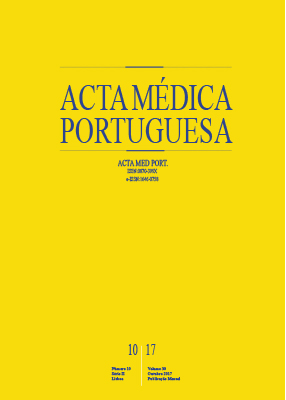The Experience of a Protocol for the Management of Pediatric Minor Head Injury: A Three Years Longitudinal Study
DOI:
https://doi.org/10.20344/amp.8795Keywords:
Brain Injuries/diagnostic imaging, Child, Craniocerebral Trauma, Tomography, X-Ray ComputedAbstract
Introduction: Head injury is common in children, with mostly being minor and not resulting in intracranial injury. Computerized tomography head scan is the preferred exam, but implies exposure to radiation; the indications for computerized tomography head scan in minor injuries are not consensual. An expectant approach is a good option in most cases. The aim was to compare the patients hospitalized and subjected to computerized tomography head scan with patients hospitalized but not subjected to computerized tomography head scan in order to assess the safety of our institution’s practice protocol.
Material and Methods: Analytical longitudinal retrospective study, during three years, including patients younger than 15 years of age with minor head injury, admitted for in hospital surveillance through a paediatric emergency room. We defined two study groups: group A (hospitalized with computerized tomography head scan) and group B (hospitalized without computerized tomography head scan).
Results: Study sample consisting of 206 patients: 81 (39%) group A and 125 (61%) group B. Symptoms, including vomiting, were more frequent in group B (91% and 61% vs 75% and 35%, p < 0.05); large scalp hematoma and palpable fracture in group A (11% and 12% vs 0%, p < 0.05). We performed computerized tomography head scan in 39% of the study patients (children with red flags in the physical examination or unfavourable course during hospitalization); 43% had traumatic brain injury (29 patients had fracture, 18 patients had intracranial injury). Three patients underwent neurosurgery. We did not register deaths, readmissions or neurologic sequelae.
Discussion: Significant intracranial injury was infrequent. The hospitalization and surveillance of children and adolescents with symptomatic minor head injury, without red flags in the physical examination, did not seem to result in additional risks.
Conclusion: The careful selection of patients for computerized tomography head scan enabled a decrease in the number of these exams and the exposure to ionizing radiation.
Downloads
Downloads
Published
How to Cite
Issue
Section
License
All the articles published in the AMP are open access and comply with the requirements of funding agencies or academic institutions. The AMP is governed by the terms of the Creative Commons ‘Attribution – Non-Commercial Use - (CC-BY-NC)’ license, regarding the use by third parties.
It is the author’s responsibility to obtain approval for the reproduction of figures, tables, etc. from other publications.
Upon acceptance of an article for publication, the authors will be asked to complete the ICMJE “Copyright Liability and Copyright Sharing Statement “(http://www.actamedicaportuguesa.com/info/AMP-NormasPublicacao.pdf) and the “Declaration of Potential Conflicts of Interest” (http:// www.icmje.org/conflicts-of-interest). An e-mail will be sent to the corresponding author to acknowledge receipt of the manuscript.
After publication, the authors are authorised to make their articles available in repositories of their institutions of origin, as long as they always mention where they were published and according to the Creative Commons license.









